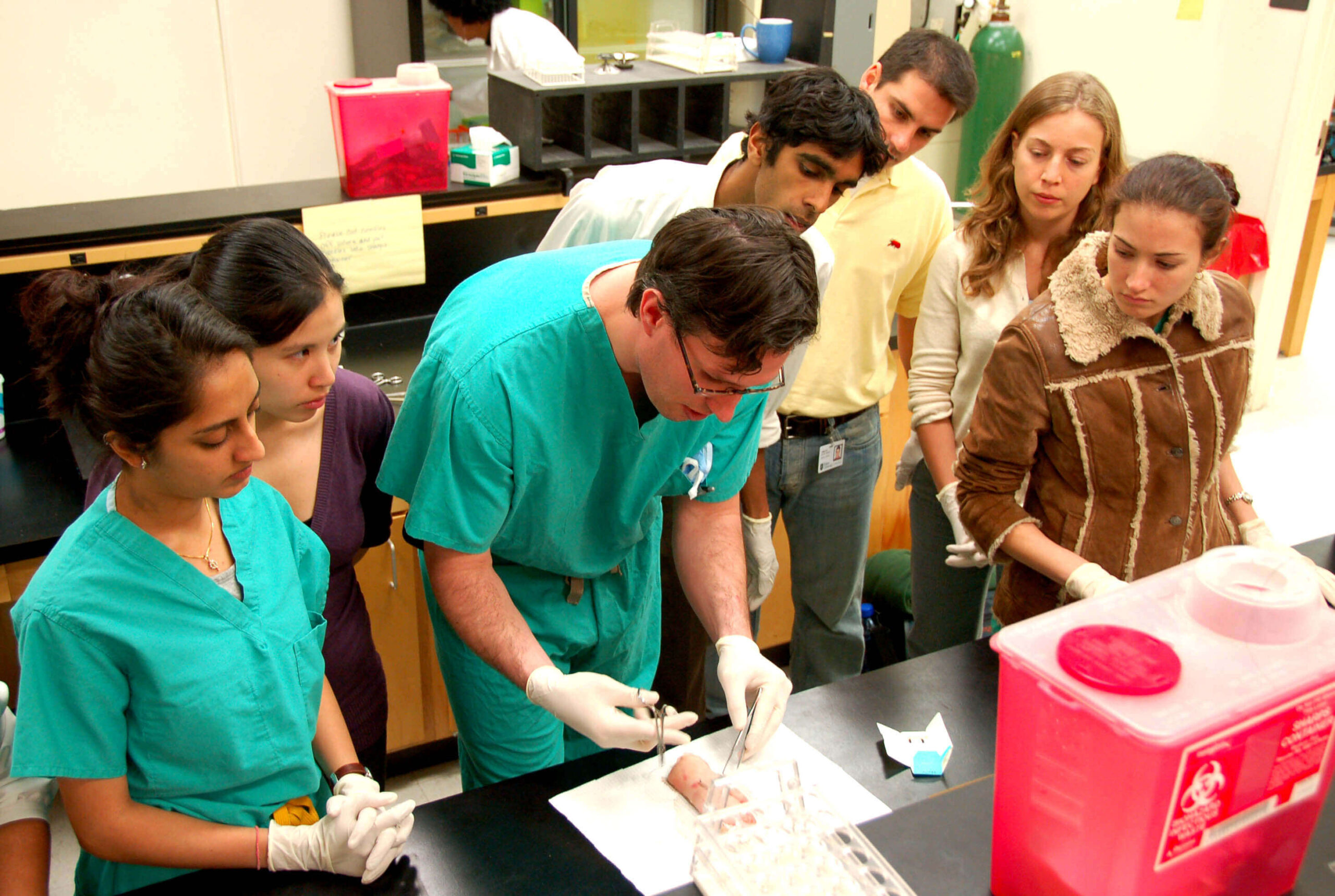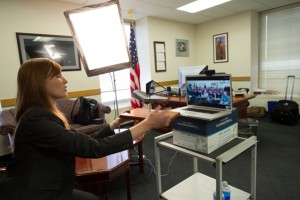- Academic Technology
The (Flipped) Classroom of the 21st Century

In recent years, non-traditional approaches to teaching have become more and more — well, traditional. In a thousand different ways, educators are shaking up the standard pedagogical approach to lecturing that dates back to ancient Greece, rewriting the rules with a mix of strategy, technology, and creativity to connect with students in ways unimaginable even just a decade ago.
Conspicuous in many of these new instructional methodologies is the presence of technology — indeed, today’s teachers are experimenting with digital initiatives across almost every aspect of the classroom, with dozens of variations for almost any given new approach.
In practice, these “blended learning” programs still vary quite a bit from school to school. A look at the bigger picture, however, reveals some clear trends developing — and right now, there may be none with more promise than the flipped classroom.
What is the Flipped Classroom?
Conceptually, the flipped classroom inverts the traditional learning experience. Lectures are shared outside of class time for individual review as homework, and classroom time is reserved for students to complete assignments and activities. The principal goals of flipping are:
- To make the classroom an active learning environment
- To enable students to learn at their own pace, and
- To give the instructor more time to teach each student individually, rather than the class as a whole.
The traditional classroom format requires teachers to spend a significant amount of class time presenting information, typically simply standing in front of a room delivering a lecture or lesson. Students sit and (to one degree or another) scribble down notes, passively receiving information at whatever speed the instructor presented. Later, after students have left the classroom and lost easy access to their teacher and peers, they are then challenged to attempt to apply the day’s lesson in individual homework assignments.
Good teachers, of course, work to read their classes’ levels of comprehension in real-time during lectures, and make adjustments to find the right speed at which to teach the average student. Likewise, attentive instructors monitor students’ understanding of the subject as demonstrated in homework, and curve the classroom to cover what will be most valuable for most students. However, many educators (and parents) today have begun voicing concerns that this “teaching to the middle” can only ever be a one-size-fits-all approach, and will nearly always fail students at the top and the bottom.
And that’s what makes a flipped classroom so promising.
By shifting passive lecture material to the at-home setting, students are given the chance to review those materials in the time and place that works best for their own needs, and to go back over important or unclear details as often as needed until they’re well understood. This, in turn, helps students to ensure they have all the foundational information they need in order to participate in interactive learning discussions and activities that push them to apply what they have learned.
Then, with in-class time reserved interactive discussion and learning, teacher-guided activities push students to put the lecture materials into practice. This classroom time may be dedicated to group work, comprehension tests, in-depth application of the subject matter, or just open time for individual assignments, all with the added benefit of having a teacher and fellow students nearby to respond when questions come up.
Stemming from that basic definition, there are dozens — if not hundreds — of ways to go about flipping a classroom. We explore several of the most popular flipped classroom examples here.
Why Flip? 5 Advantages That Go Beyond the Hype

While breakthroughs in technology may have made the flipped classroom possible, what has made it popular is something far more fundamental: flipping enhances the learning experience. Through student-led active learning, coupled with peer-to-peer collaboration and individualized guidance, flipping a classroom enables educators to adapt each lesson to the individual needs of their students like never before.
While educators’ collective understanding of the flipped classroom continues to expand, instructors (and entire institutions) at the forefront of the trend have flipped their classrooms on the basis of a handful of key benefits:
1. Flipping allows students to learn at their own pace
Under the traditional lecture model, students are bound to the pace that the instructor sets for each class session and the course as a whole. Instructors are under pressure to teach their entire curriculum within the classroom time allocated, based on the rate at which the “average” student can absorb the material. Should a student have trouble with a concept, they are forced to either interrupt and ask for the material to be repeated, thereby slowing down the session for the rest of the class, or do their best to keep up and ask for another explanation at the end or outside of normal class time.
By contrast, students in flipped classrooms can go back over any part of a recorded lecture that they are having trouble with, as many times as necessary. If they continue to have issues, they are able to come to class prepared with specific questions for their instructor.
2. Flipped learning is customized, active, and engaging
With the foundational material covered before class, instructors craft learning activities that engage students through active learning. Before class even begins, the instructor has new information at their disposal to be able to gauge the class’s level of comprehension with the lesson material. Armed with data from video analytics and online quizzes, instructors can not only ensure that students have engaged with the pre-class content, but are also able to guide the classroom experience based on what the students have learned and what remains to be learned. Gone are the days where classroom instructors had to guess at an arbitrary average.
Instructors in the flipped classroom are able to devote more time to forms of learning that put students in an active role, testing and applying the knowledge presented in the lecture. Group problem solving, student presentations, and whole group discussion shifts the focus of learning to the students themselves, to learn through experience and critical discourse. It is through these exercises that students can solidify what they have heard, test their comprehension and master the content.
3. Flipped lecture videos help student review for exams
For more than a decade, universities have been recording traditional classroom-based lectures. Many are often surprised to see not only how much video students are watching each semester, but also when in the semester the most video is consumed. In retrospect, the answer feels rather obvious: students go back to recorded lectures as a study aid during midterm and final exam periods.
Flipped classroom videos can offer the same benefit as recorded in-class lectures. When pre-class materials are made available, students can go back and review those resources to better prepare for tests and exams. Based on the experience of schools that use lecture capture technology, those materials may be one of the most valuable study guides students can have.
4. Flipped content can be richer through curation and continuous improvement
While teachers have always curated many different resources in order to complement their own lectures, flipped learning makes that process even more rich and effective and accessible. Since students are consuming lesson material at home, it need not be confined to the form of a lecture. Teachers can assign films, games, and readings, using short videos they record to tie it all together. Gone are the days of taking two class periods to watch a single film!
And as time goes on, flipped instruction benefits teachers who can make better use of their own time and resources to do progressively more each year. By flipping, teachers can:
- Save time by creating basic lecture content once and sharing it with multiple class segments for subsequent years
- Continually improve specific parts of lecture content by reviewing analytics, video comments, and discussions in class
- Allow themselves to invest time in learning and sharing new and more detailed content, either as future lessons or in classroom discussions
- Ensure their own missed classes don’t mean missed learning, by providing reliable and consistent learning materials for substitutes to use
All in all, instructors report a high level of interest in the flipped classroom. According to a report from Classroom Window, 99% of teachers who flipped one year plan to do so again and 88% said that their overall job satisfaction had improved.
5. Students in flipped classrooms perform better
Every instructor is looking for a more rewarding teaching experience; one that is engaging and directly benefits their students. As with any change, the tendencies of administrators and other stakeholders to be conservative means that for the flipped classroom to succeed, it also needs to show results where they count — at test time.
One survey showed that 67% of primary and secondary school teachers reported that their students’ test scores had improved. Another survey by the Flipped Learning network reported that 71% of teachers reported an improvement in students’ grades in the flipped classroom. And early anecdotal data abounds, with the flipped classroom garnering enthusiastic support in helping improve student performance in classrooms ranging from middle school to master’s programs.
A Modern Pedagogy for Today’s Students
The majority of students in school today were born into a world where the internet and personal computers were commonplace and information has never been more than a quick visit to Google away. They’ve carried mobile phones in their pockets since childhood and regularly communicate with each other not only through phone calls and text messages, but also through a myriad array of apps that enable communication in a thousand different ways.
Today video is a standard feature of every smartphone, tablet, laptop, and digital camera available, and a host of new websites, social networks, and mobile apps have emerged to support video sharing. In the US, three-quarters of teenagers visit YouTube daily, watching the latest music videos and viral hits no doubt, but also spending an increasing amount of time on informational, how-to, ‘edutainment’, and other content geared for self-led learning.
And while video has proven to be one of the most powerful forms for capturing and sharing information, it is not just video that has opened up learning outside the classroom: eBooks, journal databases, interactive games, and apps have all leveraged the internet and personal computing to bring newer forms of learning to greater and greater populations.
With students eager to learn in this new on-demand format, educators both inside and outside of the classroom have taken a more direct approach to spreading education via the internet. One dominant example has been experimentation with Massive Open Online Courses (MOOCs) offered by university professors in collaboration with companies like Coursera, EdX, and Udacity.
In this always-connected world, the flipped classroom represents an opportunity for teachers at all levels to advance education by leveraging students’ own expectations. Students should have the same access and convenience in school that they do in their personal lives. Technology can offer instructors an opportunity to engage with students on their own terms, in a “language” that is more familiar to this new generation of learners.
Panopto makes flipping the classroom — and flipping the teacher — easy, with flexible video presentation software that teachers and students alike can use to record lectures and presentations anytime, anywhere, from any device, and share them instantly with students, teachers, and peers on a secure, searchable video library.
Schedule a Panopto demo
Our team will contact you promptly to answer questions and schedule you for a demonstration and a free trial of our video platform.




